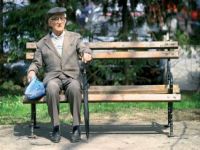Osteoporosis in men
by Varella Varella
Besides age, excessive alcohol consumption and smoking may promote the disease
 Osteoporosis is one of those medical problems that people call a woman thing. Not true, it also focuses on the male. Unfortunately, it is often underdiagnosed because most doctors do not take into account the occurrence of the condition in males.
Osteoporosis is one of those medical problems that people call a woman thing. Not true, it also focuses on the male. Unfortunately, it is often underdiagnosed because most doctors do not take into account the occurrence of the condition in males.
Without diagnosis or treatment, many older men suffer fractures that could have been avoided. At that stage of life, one third of femoral neck fractures occurs in men. For various reasons, 37% of them will die within a year.
After 70 years, bone loss is accentuated. Although after 80 the risk is higher, almost half of the fractures of the femoral neck occur before that age. About 20% of those who once broke their femur fracture them again.
Vertebral fractures are also common in males. Unlike women, however, the risk decreases with age. The prevalence after 65 drops to half that shown by women.
Although 70% to 80% of vertebral fractures are painless, they cause height loss and respiratory dysfunction, as well as increasing the risk of breaking the femur. It also compromises the quality of life and contributes to increased mortality.
Male osteoporosis often has secondary causes. Use of cortisone derivatives for more than three months, smoking, alcohol abuse and the reduction in blood levels of testosterone (hypogonadism) are the main culprits.
Approximately 15% of cases are attributed to lack of sun exposure that causes a deficiency of vitamin D, liver or kidney dysfunction, low calcium intake, reduced levels of estrogen (female hormone important for maintaining bone mass, which men also synthesize from testosterone) and the use of protease inhibitors in the treatment of AIDS.
What constitutes less common causes: body mass index below 20 (BMI = weight / height x height), excess or lack of exercise, diabetes, overactive thyroid disease, gluten, epilepsy, drugs or immunosuppressants used in organ transplants.
In up to 40% of cases, secondary causes remain uncertain.
The diagnosis is made by bone densitometry, an imaging exam that compares the bone mineral density of patients with that presented by the young and for most people the same age. In men, bone densitometry is recommended from age 70. In the groups at highest risk, assessments should begin earlier.
Treatment involves lifestyle changes and medications. Walking with weights and exercise reduces the risk of falls and fractures in older people.
Calcium and vitamin D are recommended to maintain bone mass, especially those whose diets are low in dairy products, calcium-rich foods, and those who do not catch the sun. The doses are 1200-1500 mg of calcium daily and 800 to 2 thousand units of vitamin D.
Drugs to increase bone mass should be prescribed when the result falls in the range of bone densitometry for osteoporosis. Some experts, however, prefer to prescribe them when there is osteopenia in a person who has suffered a fracture caused by a minor injury.
The first option is bisphosphonate medications, a group that includes several drugs, some for the daily administration, others weekly, monthly or every six months.
Subcutaneous administration of parathyroid hormone daily is reserved for cases of severe osteoporosis, and for those intolerant of bisphosphonates.
Although limited, studies of testosterone replacement in patients with hypogonadism show that treatment can increase the mineral density of bones. The risks involve benign prostate enlargement, sleep apnea and possibly prostate cancer.
Translated from the Portuguese version by:
Lisa Karpova
Pravda.Ru
Subscribe to Pravda.Ru Telegram channel, Facebook, RSS!





